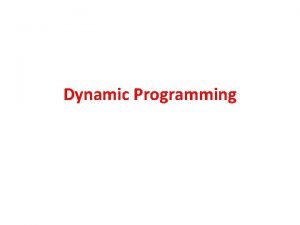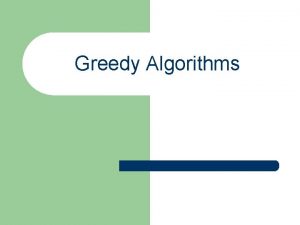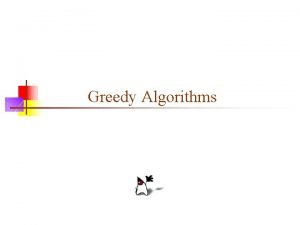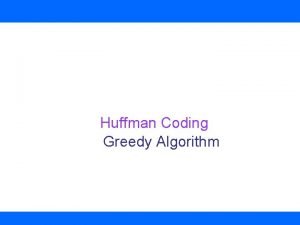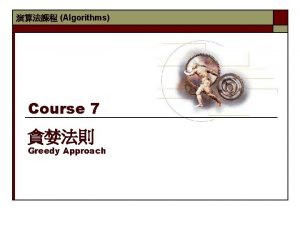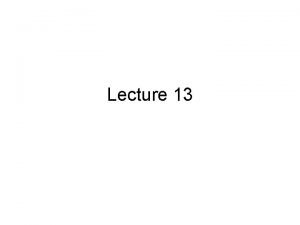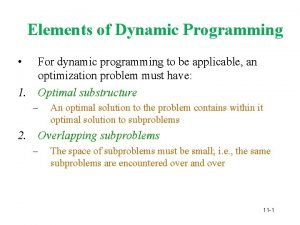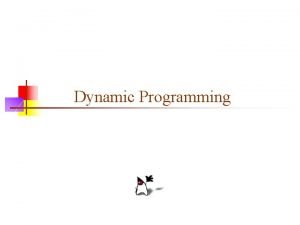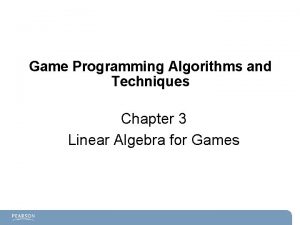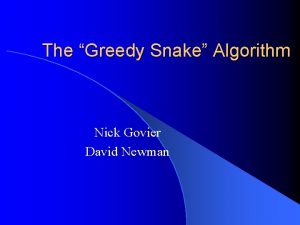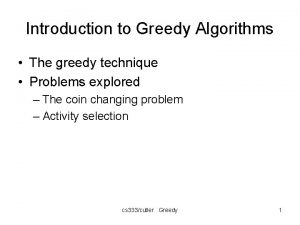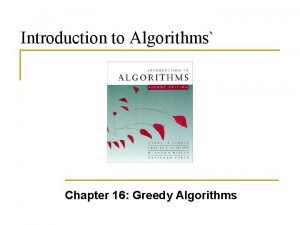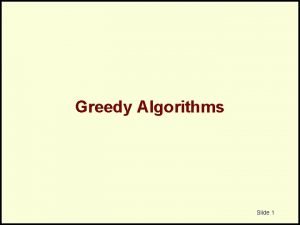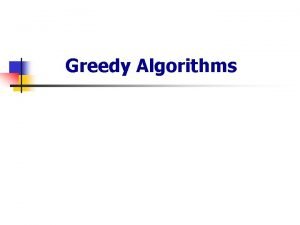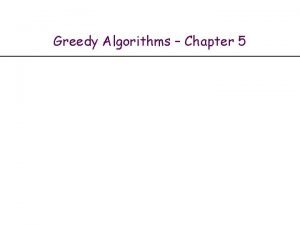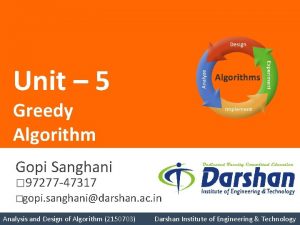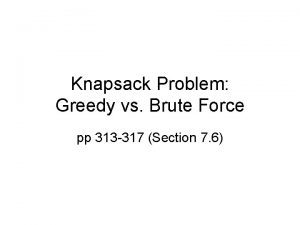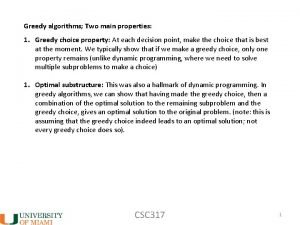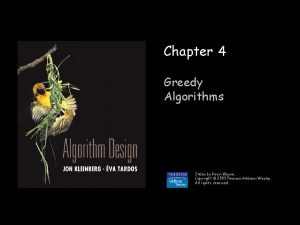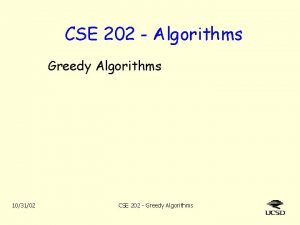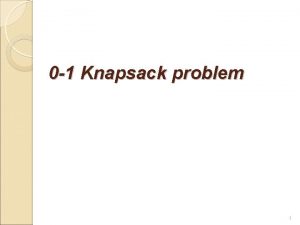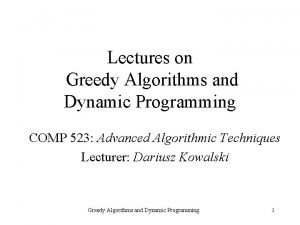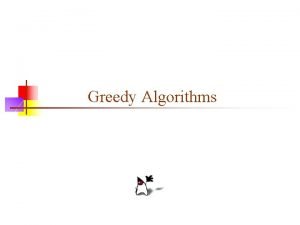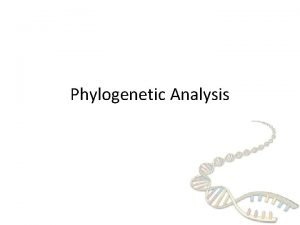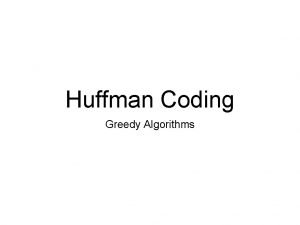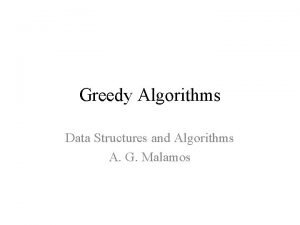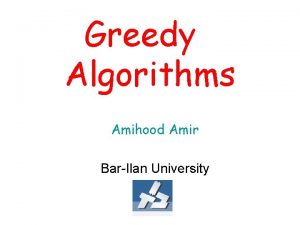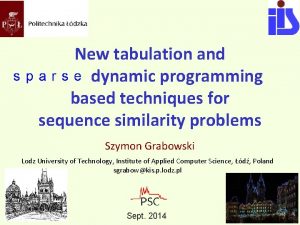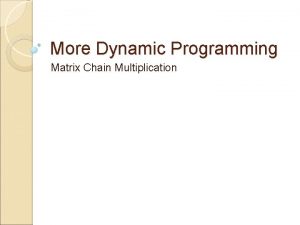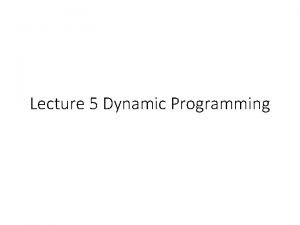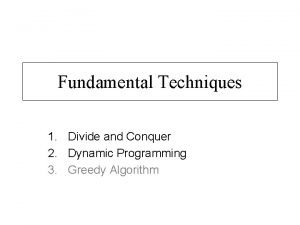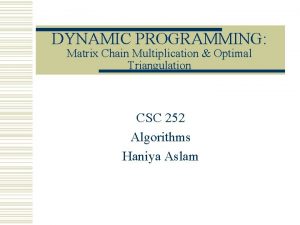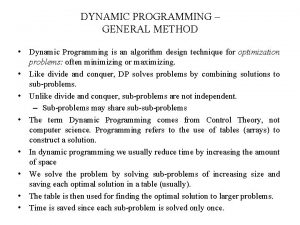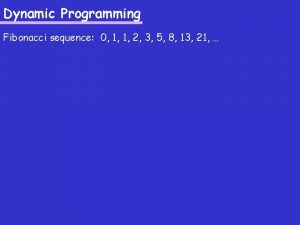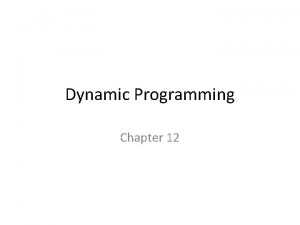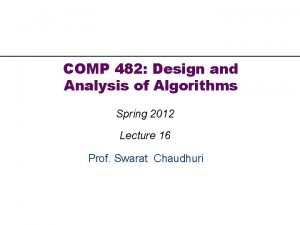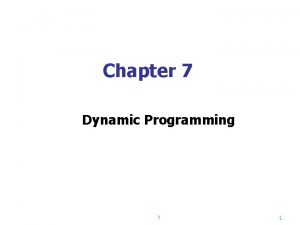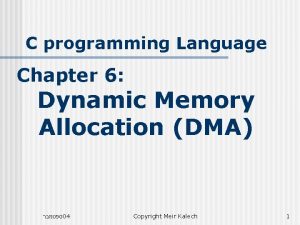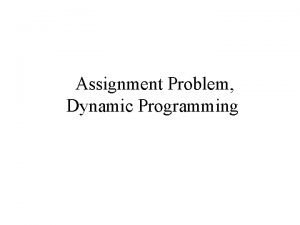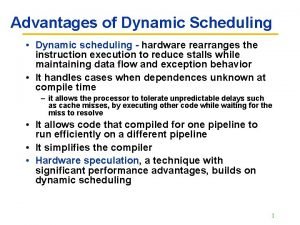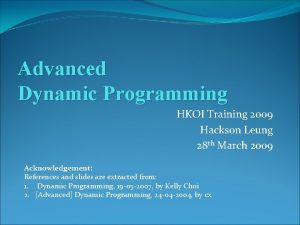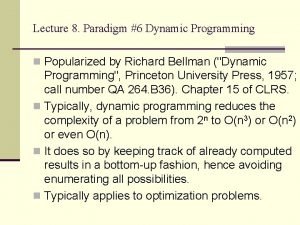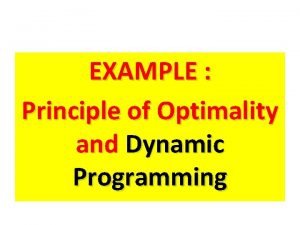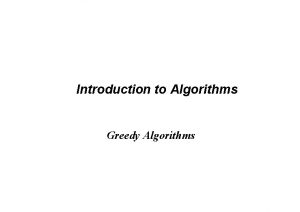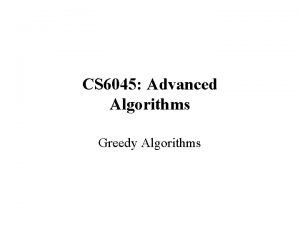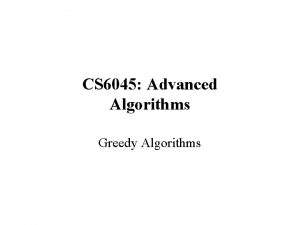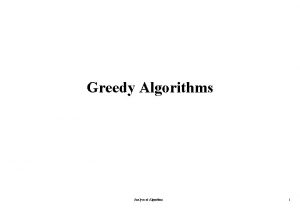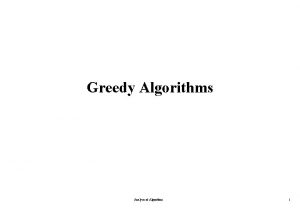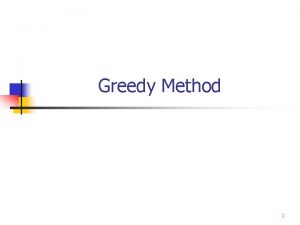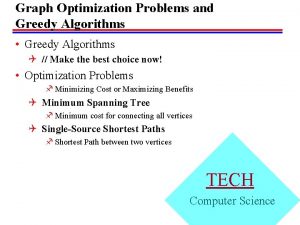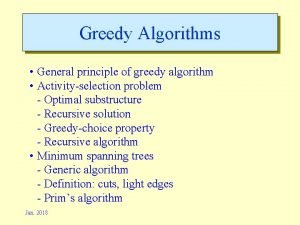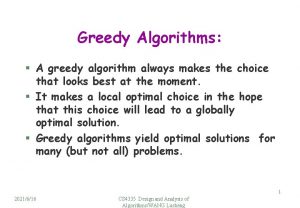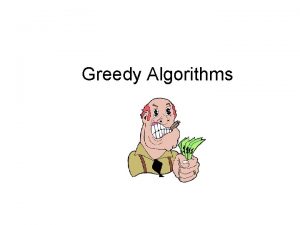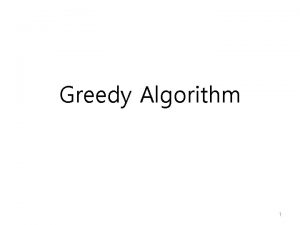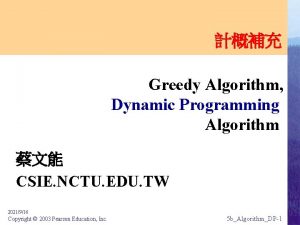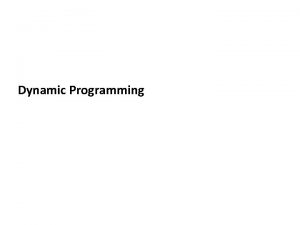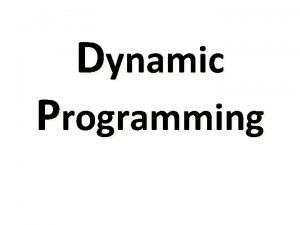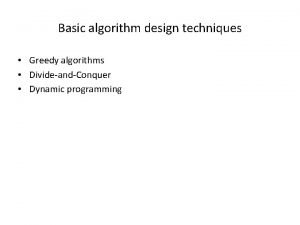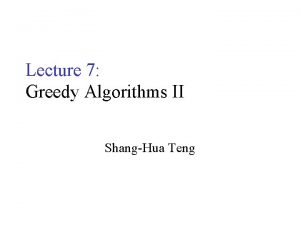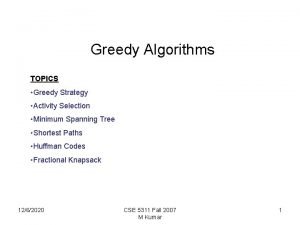More Algorithms Greedy Algorithm Dynamic Programming Algorithm tsaiwnCSIE




















































- Slides: 52

補充– More Algorithms Greedy Algorithm, Dynamic Programming Algorithm 蔡文能 tsaiwn@CSIE. NCTU. EDU. TW 2021/12/27 Reference: 計概課本 DP Algorithm-1

Agenda • Software Efficiency--Complexity of an Algorithm • Knapsack problem • Greedy Algorithm • Making Change problem • Knapsack problem • Dynamic Programming (DP) • DP vs. Divide-and-Conquer • Greedy vs. Dynamic Programming 2021/12/27 Reference: 計概課本 DP Algorithm-2

Software Efficiency – Time Complexity • Measured as number of instructions executed • notation for efficiency classes – O( ? ) – Q(? ) • Best, worst, and average case 2021/12/27 Reference: 計概課本 DP Algorithm-3

Asymptotic Upper Bound (Big O) • f(n) c g(n) for all n n 0 • g(n) is called an asymptotic upper bound of f(n). • We write f(n)=O(g(n)) • It reads f(n) equals big oh of g(n). c g(n) f(n) n 0 2021/12/27 Reference: 計概課本 DP Algorithm-4

Asymptotic Lower Bound (Big Omega) • f(n) c g(n) for all n n 0 • g(n) is called an asymptotic lower bound of f(n). • We write f(n)= (g(n)) • It reads f(n) equals big omega of g(n). f(n) c g(n) n 0 2021/12/27 Reference: 計概課本 DP Algorithm-5

Asymptotically Tight Bound (Big Theta) • f(n) = O(g(n)) and f(n) = (g(n)) • g(n) is called an asymptotically tight bound of f(n). • We write f(n)= (g(n)) • It reads f(n) equals theta of g(n). c 2 g(n) f(n) c 1 g(n) n 0 2021/12/27 Reference: 計概課本 DP Algorithm-6

Algorithm types • Algorithm types we will consider include: – Simple recursive algorithms – Backtracking algorithms – Greedy algorithms – Divide and conquer algorithms – Dynamic programming algorithms – Branch and bound algorithms – Brute force algorithms – Randomized algorithms 2021/12/27 Reference: 計概課本 DP Algorithm-7

Knapsack Problem • • • Knapsack Problem: Given n items, with item worth vi dollars and weighing wi pounds, a thief wants to take as valuable a load as possible, but can carry at most W pounds in his knapsack. The 0 -1 knapsack problem: Each item is either taken or not taken (0 -1 decision). The fractional knapsack problem: Allow to take fraction of items. (較簡單) Exp: = (60, 100, 120), = (10, 20, 30), W = 50 Greedy solution by taking items in order of greatest value per pound is optimal for the fractional version, but not for the 0 -1 version. The 0 -1 knapsack problem is NP-complete, but can be solved in O(n. W) time by Dynamic Programming. (A polynomial-time DP? ? ) 2021/12/27 Reference: 計概課本 DP Algorithm-8

The Fractional Knapsack Problem • Given: A set S of n items, with each item i having – bi - a positive benefit – wi - a positive weight • Goal: Choose items with maximum total benefit but with weight at most W. • If we are allowed to take fractional amounts, then this is the fractional knapsack problem. – In this case, we let xi denote the amount we take of item i – Objective: maximize – Constraint: 2021/12/27 Reference: 計概課本 DP Algorithm-9

The Fractional Knapsack Algorithm • Greedy choice: Keep taking item with highest value (benefit Algorithm fractional. Knapsack(S, W) Input: set S of items w/ benefit bi to weight ratio) and weight w ; max. weight W – Since – Run time: O(n log n). Why? • Correctness: Suppose there is a better solution 2021/12/27 – there is an item i with higher value than a chosen item j, but xi<wi, xj>0 and vj<vi – If we substitute some j with i, we get a better solution – How much of i: min{wi-xi, xj} – Thus, there is no better solution than the greedy one Reference: 計概課本 i Output: amount xi of each item i to maximize benefit w/ weight at most W for each item i in S xi 0 vi bi / wi {value} w 0 {total weight} while w < W remove item i w/ highest vi xi min{wi , W - w} w w + min{wi , W - w} DP Algorithm-10

0 -1 Knapsack problem (1/5) • Given a knapsack with maximum capacity W, and a set S consisting of n items • Each item i has some weight wi and benefit value bi (all wi , bi and W are integer values) • Problem: How to pack the knapsack to achieve maximum total value of packed items? 2021/12/27 Reference: 計概課本 DP Algorithm-11

0 -1 Knapsack problem (2/5) Weight This is a knapsack Max weight: W = 20 Items wi Benefit value bi 2 3 3 4 5 5 8 9 10 4 2021/12/27 Reference: 計概課本 DP Algorithm-12

0 -1 Knapsack problem (3/5) • Problem, in other words, is to find • The problem is called a “ 0 -1” Knapsack problem, because each item must be entirely accepted or rejected. • Another version of this problem is the “Fractional Knapsack Problem”, where we can take fractions of items. 2021/12/27 Reference: 計概課本 DP Algorithm-13

0 -1 Knapsack problem (4/5) Let’s first solve this problem with a straightforward algorithm (Brute-force) ü Since there are n items, there are 2 n possible combinations of items. ü We go through all combinations and find the one with the most total value and with total weight less or equal to W. ü Running time will be O(2 n) 2021/12/27 Reference: 計概課本 DP Algorithm-14


0 -1 Knapsack problem (5/5) • Can we do better? – Yes, with an algorithm based on Dynamic programming – We need to carefully identify the subproblems Key point: If items are labeled 1. . n, then a subproblem would be to find an optimal solution for Sk = {items labeled 1, 2, . . k} 2021/12/27 Reference: 計概課本 DP Algorithm-16

Algorithm types • Algorithm types we will consider include: – Simple recursive algorithms – Backtracking algorithms – Greedy algorithms – Divide and Conquer algorithms – Dynamic programming algorithms – Branch and bound algorithms – Brute force algorithms – Randomized algorithms 2021/12/27 Reference: 計概課本 DP Algorithm-17

The Greedy Method Technique • The greedy method is a general algorithm design paradigm, built on the following elements: – configurations: different choices, collections, or values to find – objective function: a score assigned to configurations, which we want to either maximize or minimize – A greedy algorithm always makes the choice that looks best at the moment. (時到時擔當, 沒米再煮蕃薯塊湯) – Top-down algorithmic structure • With each step, reduce problem to a smaller problem • It works best when applied to problems with the greedychoice property: – a globally-optimal solution can always be found by a series of local improvements from a starting configuration. 2021/12/27 The greedy method cannot always find an optimal solution! Reference: 計概課本 DP Algorithm-18

Coin Changing problem • Problem: A dollar amount to reach and a collection of coin amounts to use to get there. – Configuration: A dollar amount yet to return to a customer plus the coins already returned – Objective function: Minimize number of coins returned. Coins in USA: 1¢ 5¢ 10 ¢ 25 ¢ 50 ¢ • Greedy solution: Always return the largest coin you can – Example 1: Coins are valued $. 32, $. 08, $. 01 • Has the greedy-choice property, since no amount over $. 32 can be made with a minimum number of coins by omitting a $. 32 coin (similarly for amounts over $. 08, but under $. 32). 2021/12/27 Reference: 計概課本 DP Algorithm-19

Greedy Algorithm for Coin Changing problem This algorithm makes change for an amount A using coins of denominations denom[1] > denom[2] > ··· > denom[n] = 1. Input Parameters: denom, A Output Parameters: None greedy_coin_change(int denom[], int A) { i = 1 while (A > 0) { c = A/denom[ i ] println(“use ” + c + “ coins of denomination ” + denom[i]) A = A - c * denom[i] i = i + 1 } } 2021/12/27 Reference: 計概課本 DP Algorithm-20

Question ? Suppose there are unlimited quantities of coins of each denomination. What property should the denominations c 1, c 2, …, ck have so that the greedy algorithm always yields an optimal solution? ü Consider this example: – Example 2: Coins are valued $. 30, $. 20, $. 05, $. 01 • Does not have greedy-choice property, since $. 40 is best made with two $. 20’s, but the greedy solution will pick three coins (which ones? ) The greedy method cannot always find an optimal solution! 2021/12/27 Reference: 計概課本 DP Algorithm-21

Consider the Coin set for examples • For the following examples, we will assume coins in the following denominations: 1¢ 5¢ 10¢ 21¢ 25¢ • We’ll use 63¢ as our goal • This example is taken from: Data Structures & Problem Solving using Java by Mark Allen Weiss The greedy method cannot always find an optimal solution! 2021/12/27 Reference: 計概課本 DP Algorithm-22

(1) A simple solution • We always need a 1¢ coin, otherwise no solution exists for making one cent • To make K cents: – If there is a K-cent coin, then that one coin is the minimum – Otherwise, for each value i < K, • Find the minimum number of coins needed to make i cents • Find the minimum number of coins needed to make K - i cents – Choose the i that minimizes this sum • This algorithm can be viewed as divide-and-conquer, or as brute force – This solution is very recursive – It requires exponential work – It is infeasible to solve for 63¢ 2021/12/27 Reference: 計概課本 DP Algorithm-23

(2) Another solution • We can reduce the problem recursively by choosing the first coin, and solving for the amount that is left • For 63¢: – – – One 1¢ coin plus the best solution for 62¢ One 5¢ coin plus the best solution for 58¢ One 10¢ coin plus the best solution for 53¢ One 21¢ coin plus the best solution for 42¢ One 25¢ coin plus the best solution for 38¢ • Choose the best solution from among the 5 given above • Instead of solving 62 recursive problems, we solve 5 • This is still a very expensive algorithm 2021/12/27 Reference: 計概課本 DP Algorithm-24

(3) A dynamic programming solution • Idea: Solve first for one cent, then two cents, then three cents, etc. , up to the desired amount – Save each answer in an array ! • For each new amount N, compute all the possible pairs of previous answers which sum to N – For example, to find the solution for 13¢, • First, solve for all of 1¢, 2¢, 3¢, . . . , 12¢ • Next, choose the best solution among: – – – Solution for 1¢ Solution for 2¢ Solution for 3¢ Solution for 4¢ Solution for 5¢ Solution for 6¢ + + + solution for 12¢ solution for 11¢ solution for 10¢ solution for 9¢ solution for 8¢ solution for 7¢ 2021/12/27 Reference: 計概課本 DP Algorithm-25

Example using dynamic programming • Suppose coins are 1¢, 3¢, and 4¢ – – – There’s only one way to make 1¢ (one coin) To make 2¢, try 1¢+1¢ (one coin + one coin = 2 coins) To make 3¢, just use the 3¢ coin (one coin) To make 4¢, just use the 4¢ coin (one coin) To make 5¢, try • 1¢ + 4¢ (1 coin + 1 coin = 2 coins) • 2¢ + 3¢ (2 coins + 1 coin = 3 coins) • The first solution is better, so best solution is 2 coins – To make 6¢, try • 1¢ + 5¢ (1 coin + 2 coins = 3 coins) • 2¢ + 4¢ (2 coins + 1 coin = 3 coins) • 3¢ + 3¢ (1 coin + 1 coin = 2 coins) – best solution – Etc. 2021/12/27 Reference: 計概課本 DP Algorithm-26

How good is the algorithm? • The first algorithm is recursive, with a branching factor of up to 62 – Possibly the average branching factor is somewhere around half of that (31) – The algorithm takes exponential time, with a large base • The second algorithm is much better—it has a branching factor of 5 – This is exponential time, with base 5 • The dynamic programming algorithm is O(N*K), where N is the desired amount and K is the number of different kinds of coins 2021/12/27 Reference: 計概課本 DP Algorithm-27

Dynamic Programming (DP) ? • Like divide-and-conquer, solve problem by combining the solutions to sub-problems. • Differences between divide-and-conquer and DP: – Independent sub-problems, solve sub-problems independently and recursively, (so same sub(sub)problems solved repeatedly) – Sub-problems are dependent, i. e. , sub-problems share sub-subproblems, every sub(sub)problem solved just once, solutions to sub(sub)problems are stored in a table and used for solving higher level sub-problems. • DP reduces computation by – Solving subproblems in a bottom-up fashion. – Storing solution to a subproblem the first time it is solved. – Looking up the solution when subproblem is encountered again. 2021/12/27 Reference: 計概課本 DP Algorithm-28

Fibonacci sequence (1/4) • Fibonacci sequence: 1 , 2 , 3 , 5 , 8 , 13 , 21 , … Fi = 1 if i ==1 or i == 2 (assume F 0 = 0) Fi = Fi-1 + Fi-2 if i 3 • Solved by a recursive program: • Much replicated computation is done. • It should be solved by a simple loop. 2021/12/27 Reference: 計概課本 DP Algorithm-29

Fibonacci Sequence (2/4) • Recursive logic: – F 1 = F 2 = 1 – If i > 2 then Fi = Fi-1 + F i-2 • Directly translates into a recursive algorithm F: F(i) { if (i = 1) or (i = 2) x 1 else x F(i-1) + F(i-2) return x } • F’s call tree is exponential; F is recomputed many times for the same input value! We can speed things up by storing output values of F in an array AF F(i) { if (AF != NULL) return AF if (i = 1) or (i = 2) x 1 else x F(i-1) + F(i-2) AF x return x } Since there are n cells in AF and each cell takes O(1) time to compute, this is O(n)! 2021/12/27 Reference: 計概課本 DP Algorithm-30

Fibonacci Sequence (3/4) We have sped things up by storing output values of F in an array AF The final algorithm is: But we don’t need recursion at all, just a loop through AF! This is a dynamic programming algorithm! F(i) { if (AF != NULL) return AF if (i = 1) or (i = 2) x 1 else x F(i-1) + F(i-2) AF x return x } Fib(n) { AF new array of n int’s for (i = 1 to n) { if (i = 1) or (i = 2) x 1 else x F(i-1) + F(i-2) AF[i] x } return AF[n] } 2021/12/27 Reference: 計概課本 DP Algorithm-31

Fibonacci Sequence (4/4) using Dynamic programming • Dynamic programming calculates from bottom to top. (bottom-up) • Values are stored for later use. • This reduces repetitive calculation. 2021/12/27 Reference: 計概課本 Pascal Triangle ? DP Algorithm-32

Application domain of DP • Optimization problem: find a solution with optimal (maximum or minimum) value. • An optimal solution, not the optimal solution, since may more than one optimal solution, any one is OK. • Dynamic Programming is an algorithm design method that can be used when the solution to a problem may be viewed as the result of a sequence of decisions 2021/12/27 Reference: 計概課本 DP Algorithm-33

Typical steps of DP • Characterize the structure of an optimal solution. • Recursively define the value of an optimal solution. • Compute the value of an optimal solution in a bottom-up fashion. • Compute an optimal solution from computed/stored information. 2021/12/27 Reference: 計概課本 DP Algorithm-34

Comparison with Divide-and-Conquer • Divide-and-conquer algorithms split a problem into separate subproblems, solve the subproblems, and combine the results for a solution to the original problem – Example: Quicksort – Example: Mergesort – Example: Binary search Divide-and-Conquer 分割征服 ; 各個擊破; 拆解 • Divide-and-Conquer algorithms can be thought of as top-down algorithms • In contrast, a dynamic programming algorithm proceeds by solving small problems, then combining them to find the solution to larger problems • Dynamic programming can be thought of as bottom-up 2021/12/27 Reference: 計概課本 DP Algorithm-35

Divide and Conquer • Divide the problem into a number of sub -problems (similar to the original problem but smaller); • Conquer the sub-problems by solving them recursively (if a sub-problem is small enough, just solve it in a straightforward manner (base case). ) • Combine the solutions to the sub-problems into the solution for the original problem 2021/12/27 Reference: 計概課本 DP Algorithm-36

Divide and Conquer example : Merge Sort • Divide the n-element sequence to be sorted into two subsequences of n/2 element each • Conquer: Sort the two subsequences recursively using merge sort • Combine: merge the two sorted subsequences to produce the sorted answer • Note: during the recursion, if the subsequence has only one element, then do nothing. 2021/12/27 Reference: 計概課本 DP Algorithm-37

Comparison with Greedy • Common: optimal substructure – Optimal substructure: An optimal solution to the problem contains within its optimal solutions to subproblems. • E. g. , if A is an optimal solution to S, then A' = A - {1} is an optimal solution to S' = {i S: si f 1}. • Difference: greedy-choice property – Greedy: A global optimal solution can be arrived at by making a locally optimal choice. – Dynamic programming needs to check the solutions to subproblems. • DP can be used if greedy solutions are not optimal. The greedy method cannot always find an optimal solution! 2021/12/27 Reference: 計概課本 DP Algorithm-38

Greedy vs. Dynamic Programming • The knapsack problem is a good example of the difference. • 0 -1 knapsack problem: not solvable by greedy. – – n items. Item i is worth $vi , weighs wi pounds. Find a most valuable subset of items with total weight ≤ W. Have to either take an item or not take it—can’t take part of it. • Fractional knapsack problem: solvable by greedy – Like the 0 -1 knapsack problem, but can take fraction of an item. – Both have optimal substructure. – But the fractional knapsack problem has the greedy-choice property, and the 0 -1 knapsack problem does not. – To solve the fractional problem, rank items by value/weight: vi / wi. – Let v i / wi ≥ vi+1 / wi+1 for all i. The greedy method cannot always find an optimal solution! 2021/12/27 Reference: 計概課本 DP Algorithm-39

Divide-and-Conquer in Sorting • Mergesort – O(n log n) always, but O(n) storage • Quick sort – O(n log n) average, O(n^2) worst in time – O(log n) storage – Good in practice (>12) 2021/12/27 Reference: 計概課本 DP Algorithm-40

Computer Game-playing • Can computers beat humans in board games like Chess, Checkers, Go, 六子棋? • This is one of the first tasks of Artificial Intelligence (Shannon 1950) • Successes obtained in Chess (Deep Blue), Checkers, Draughts, Backgammon, Scrabble. . . 2021/12/27 Reference: 計概課本 DP Algorithm-41

Game-playing • Domain: two-player zero-sum game with perfect information (Zermelo, 1913) • Task: find best response to opponent’s moves, provided that the opponent does the same • Solution: Minimax procedure (von Neumann, 1928) 2021/12/27 Reference: 計概課本 DP Algorithm-42

Heuristic Search. 25 1 2 . 25 1 . 25 3 – 1 2 3 . 33 . 5 1 . 33 2 . 5 – 1 3 – 1 1 . 5 2 – 1 • Truncate the game tree (depth + selection) • Use a (static heuristic) evaluation function at the leafs to replace pay-offs • Miminax on the reduced game tree 2021/12/27 Reference: 計概課本 DP Algorithm-43

Mini. Max procedure in Game-playing +1 1 MINIMAXING +1 1 – 1 1 2 2 – 1 2 3 +1 1 3 1 +1 2 +1 1 1 2 1 +1 – 1 – 1 3 1 2 +1 – 1 2 1 – 1 +1 +1 2 3 1 +1 1 – 1 1 +1 +1 – 1 +1 +1 – 1 2021/12/27 Reference: 計概課本 DP Algorithm-44

Search in Games Consider tic-tac-toe as a search problem. States, neighbors, goal? O O O X X X 2021/12/27 Reference: 計概課本 DP Algorithm-45

Using opponent’s strategy • Well known Tic-Tac-Toe strategy: – make 3 -in-a-row if possible – prevent opponent’s 3 -in-a-row if possible – occupy central square if possible – occupy corner square if possible knows that uses this strategy 2021/12/27 Reference: 計概課本 DP Algorithm-46

Opponent-Model search Iida, vd Herik, Uiterwijk (1993) Carmel and Markovitch (1993) • Opponent’s evaluation function is known (unilateral: the opponent uses minimax) • This is the opponent model • It is used to predict opponent’s moves • Best response is determined, using the own evaluation function 2021/12/27 Reference: 計概課本 DP Algorithm-47

Nim: Example Game n piles of sticks, ci sticks in pile i X: sizes of piles on player 1’s turn Y: sizes of piles on player 2’s turn N(s): all reductions of a pile by one or more, swapping turns G(s): all sticks gone V(s): +1 if s in X, else -1 (lose if take last stick) 2021/12/27 Reference: 計概課本 DP Algorithm-48

Heuristic Evaluation Familiar idea: Compute h(s), a value meant to correlate with the game-theoretic value of the game. After searching as deeply as possible, plug in h(s) instead of searching to leaves. 2021/12/27 Reference: 計概課本 DP Algorithm-49

Game Othello • Two-player game played on 8 x 8 board • All pieces have one white side and one black side • Initial board setup is shown right, with valid moves marked as dots Free online Othello game http: //brittany. angloinfo. com/games/iago. asp 2021/12/27 Reference: 計概課本 DP Algorithm-50

The Evolution of Strong Othello Programs Michael Buro, 2003 • First computer Othello tournaments in 1979 • In 1980, first time a World-champion lost a game of skill against a computer • 6 -0 defeat of then human World-champion in 1997 • Michael Buro http: //www. cs. ualberta. ca/~mburo/ 2021/12/27 Reference: 計概課本 DP Algorithm-51

Evaluation Function Evolution • Mini-max search used to estimate the chance of winning for the player with current move • Construct function using features of board state that correlate with winning • Important features – Disc stability – stable discs cannot be flipped – Disc mobility – move options – Disc parity – last move opportunities for every empty board region 2021/12/27 Reference: 計概課本 DP Algorithm-52
 Lirik lagu more more more we praise you
Lirik lagu more more more we praise you More more more i want more more more more we praise you
More more more i want more more more more we praise you Greedy vs dynamic
Greedy vs dynamic Divide and conquer and greedy method
Divide and conquer and greedy method Greedy algorithms
Greedy algorithms List of greedy algorithms
List of greedy algorithms Huffman coding method
Huffman coding method Fractional knapsack problem
Fractional knapsack problem Programming
Programming What are the elements of dynamic programming
What are the elements of dynamic programming Dynamic programming algorithm
Dynamic programming algorithm Computational thinking algorithms and programming
Computational thinking algorithms and programming Synchronization algorithms and concurrent programming
Synchronization algorithms and concurrent programming Dot product rules
Dot product rules The greedy snake
The greedy snake Workplace problems
Workplace problems Greedy algorithm
Greedy algorithm Activity selection problem greedy algorithm example
Activity selection problem greedy algorithm example Matroid greedy
Matroid greedy Interval scheduling greedy algorithm
Interval scheduling greedy algorithm Activity selection problem greedy algorithm
Activity selection problem greedy algorithm Greedy algorithm for job sequencing with deadlines
Greedy algorithm for job sequencing with deadlines Knapsack problem
Knapsack problem Greedy property
Greedy property Offline caching greedy algorithm
Offline caching greedy algorithm Coin change problem greedy algorithm proof
Coin change problem greedy algorithm proof 0/1 knapsack problem greedy algorithm
0/1 knapsack problem greedy algorithm Time complexity of greedy algorithm
Time complexity of greedy algorithm N/a greedy
N/a greedy General principle of greedy algorithm
General principle of greedy algorithm Prefix free
Prefix free Greedy algorithm definition
Greedy algorithm definition Amihood amir
Amihood amir Greedy algorithm
Greedy algorithm Transferered
Transferered Tabulation in dynamic programming
Tabulation in dynamic programming Matrix chain multiplication dynamic programming
Matrix chain multiplication dynamic programming A b a b c d e
A b a b c d e Dynamic programming bottom up
Dynamic programming bottom up Dynamic programming vs divide and conquer
Dynamic programming vs divide and conquer General method for dynamic programming
General method for dynamic programming Dynamic programming excel
Dynamic programming excel Fibonacci series dynamic programming
Fibonacci series dynamic programming Egg drop dynamic programming
Egg drop dynamic programming 4d3d41669541f1bf19acde21e19e43d23ebbd23b
4d3d41669541f1bf19acde21e19e43d23ebbd23b Multistage graph forward and backward approach
Multistage graph forward and backward approach Dma dynamic memory allocation
Dma dynamic memory allocation Assignment problem dynamic programming
Assignment problem dynamic programming Advantages of dynamic programming
Advantages of dynamic programming Dynamic programming bottom up
Dynamic programming bottom up Knapsack dynamic programming
Knapsack dynamic programming Dynamic programming paradigm
Dynamic programming paradigm Principle of optimality
Principle of optimality



